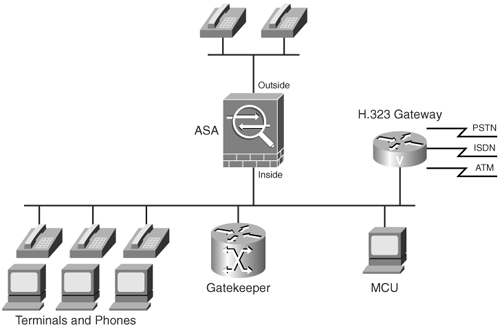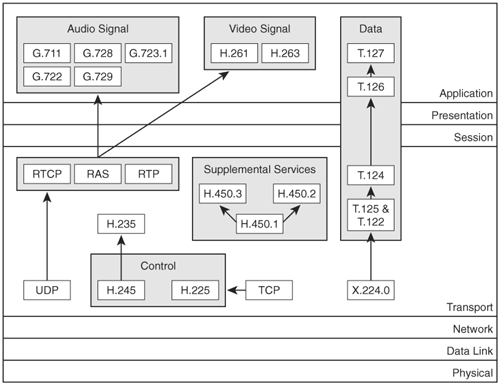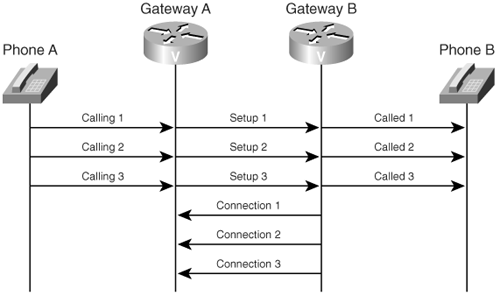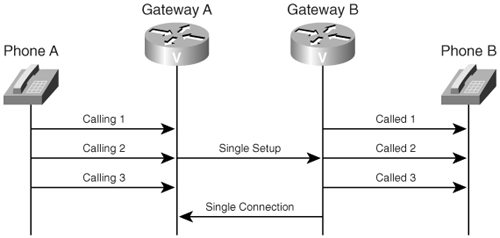H.323
The H.323 standard stipulates the components, protocols, and procedures that provide multimedia communication services (audio, video, and data) over IP-based networks. Four kinds of H.323 components provide point-to-point and point-to-multipoint multimedia communication services:
- Terminals Endpoints on the network that provide real-time two-way communications. For example, Cisco IP Phones.
- Gateways Provide translation between circuit-switched networks and packet-based networks, enabling the endpoints to communicate.
- Gatekeepers Responsible for call control and routing services to H.323 endpoints, system management, and some security policies.
- Multipoint control units (MCUs) Maintain all the audio, video, data, and control streams between all the participants in the conference.
Figure 8-7 shows a basic network topology that illustrates the components of H.323.
Figure 8-7. H.323 Components

H.323 Protocol Suite
Figure 8-8 illustrates the H.323 protocol suite:
- The G.7xx components are audio codecs.
- The H.26x components are video codecs. The standard is H.261.
Audio and video components sit on top of the Real-Time Transport Protocol (RTP).
- The T.12x protocols are used in real-time exchange of data. One example is an online whiteboard application.
Figure 8-8. H.323 Protocols

In Figure 8-8, the protocols are illustrated in relation to the respective OSI layers.
The H.323 suite of protocols may use up to two TCP connections and four to six UDP connections:
- RTP uses the Real-Time Transport Control Protocol (RTCP) to control and synchronize streaming audio and video. It allows the application to adapt the flow to specific network conditions.
- Terminals and gatekeepers use Registration, Admission, and Status (RAS) Protocol to exchange information about call registrations, admissions, and terminations. This protocol communicates over UDP.
Note
The FastConnect H.323 feature uses only one TCP connection, and RAS uses UDP requests and responses for registration, admissions, and status.
- H.225 is a protocol used to establish connections between two terminals. It runs over TCP.
- H.245 is a protocol used between two terminals to exchange control messages. These messages include flow control and channel management commands.
- Clients may request a Q.931 call setup over TCP port 1720 to H.323 servers. During the call setup process, the H.323 terminal provides the TCP port number for the client to use for an H.245 connection.
Note
The initial packet is transmitted over UDP if H.323 gatekeepers are used.
- The Cisco ASA can monitor the Q.931 TCP connection to determine the H.245 port number. It dynamically allocates the H.245 connection based on the inspection of the H.225 messages if FastConnect is not used.
- The terminals negotiate the port numbers to be used for subsequent UDP streams within each H.245 message. The Cisco ASA also monitors the H.245 messages to know about these ports and to create the necessary connections.
Note
RTP uses the negotiated port number; however, RTCP uses the next higher port number.
The following are the key TCP and UDP ports in H.323 inspection:
- Gatekeeper discovery UDP port 1718
- RAS UDP port 1719
- Control port TCP port 1720
H.323 Version Compatibility
Cisco ASA is compatible with H.323 versions 1, 2, 3, and 4. Figure 8-9 and Figure 8-10 show a major difference between older versions of H.323 and H.323v3 and higher.
Figure 8-9. Call Setup Pre-H.323v3

Figure 8-10. H.323v3 Call Setup Features

H.323v3 and higher supports multiple calls on one signaling connection. It accomplishes this by examining the call reference value (CRV) within the Q.931 message, as shown in Figure 8-10. This results in reduced call setup and clearing times.
Enabling H.323 Inspection
To enable H.323 inspection for H.225, use the inspect h323 h225 command. For RAS, use the inspect h323 ras command. Example 8-11 shows both commands.
Example 8-11. H.323 Inspection Commands
policy-map asa_global_fw_policy class inspection_default inspect h323 h225 inspect h323 ras
The Cisco ASA can translate the necessary embedded IP addresses in the H.225 and H.245 packets. It also can translate H.323 connections. It uses an ASN.1 decoder to decode the H.323 Packet Encoding Rules (PER) encoded messages. The Cisco ASA also dynamically allocates the negotiated H.245, RTP, and RTCP sessions.
Additionally, the Cisco ASA analyses the TPDU Packet (TPKT) header to define the length of the H.323 messages. In H.323, Q.931 messages are exchanged over a TCP stream demarcated by TPKT encapsulations. It maintains a data structure for each connection also containing the TPKT length for the following H.323 messages.
Note
Cisco ASA also supports segmented TPKT messages.
Direct Call Signaling and Gatekeeper Routed Control Signaling
Two control-signaling methods are defined in the ITU-T H.323 recommendation:
- Direct Call Signaling (DCS)
- Gatekeeper Routed Control Signaling (GKRCS)
Cisco ASA supports both methods. The Cisco ASA inspects DSC and GKRCS to ensure that the negotiation messages and correct fields are transferred between the respective devices. GKRCS inspection is done when H.323 inspection is enabled in the Cisco ASA. No additional configuration is needed.
Note
The Cisco ASA must see the calling endpoint address within the initial H.225 setup information in order to allow the respective connection.
T.38
T.38 is the protocol used with Fax over IP (FoIP). This protocol is part of the ITU-T H.323 VoIP architecture. Cisco ASA supports inspection of this protocol. Because T.38 is a part of the H.323 protocol, inspection will be done if H.323 inspection is enabled on the Cisco ASA. No additional configuration is needed.
Part I: Product Overview
Introduction to Network Security
- Introduction to Network Security
- Firewall Technologies
- Intrusion Detection and Prevention Technologies
- Network-Based Attacks
- Virtual Private Networks
- Summary
Product History
- Product History
- Cisco Firewall Products
- Cisco IDS Products
- Cisco VPN Products
- Cisco ASA All-in-One Solution
- Summary
Hardware Overview
Part II: Firewall Solution
Initial Setup and System Maintenance
- Initial Setup and System Maintenance
- Accessing the Cisco ASA Appliances
- Managing Licenses
- Initial Setup
- IP Version 6
- Setting Up the System Clock
- Configuration Management
- Remote System Management
- System Maintenance
- System Monitoring
- Summary
Network Access Control
- Network Access Control
- Packet Filtering
- Advanced ACL Features
- Content and URL Filtering
- Deployment Scenarios Using ACLs
- Monitoring Network Access Control
- Understanding Address Translation
- DNS Doctoring
- Monitoring Address Translations
- Summary
IP Routing
Authentication, Authorization, and Accounting (AAA)
- Authentication, Authorization, and Accounting (AAA)
- AAA Protocols and Services Supported by Cisco ASA
- Defining an Authentication Server
- Configuring Authentication of Administrative Sessions
- Authenticating Firewall Sessions (Cut-Through Proxy Feature)
- Configuring Authorization
- Configuring Accounting
- Deployment Scenarios
- Troubleshooting AAA
- Summary
Application Inspection
- Application Inspection
- Enabling Application Inspection Using the Modular Policy Framework
- Selective Inspection
- Computer Telephony Interface Quick Buffer Encoding Inspection
- Domain Name System
- Extended Simple Mail Transfer Protocol
- File Transfer Protocol
- General Packet Radio Service Tunneling Protocol
- H.323
- HTTP
- ICMP
- ILS
- MGCP
- NetBIOS
- PPTP
- Sun RPC
- RSH
- RTSP
- SIP
- Skinny
- SNMP
- SQL*Net
- TFTP
- XDMCP
- Deployment Scenarios
- Summary
Security Contexts
- Security Contexts
- Architectural Overview
- Configuration of Security Contexts
- Deployment Scenarios
- Monitoring and Troubleshooting the Security Contexts
- Summary
Transparent Firewalls
- Transparent Firewalls
- Architectural Overview
- Transparent Firewalls and VPNs
- Configuration of Transparent Firewall
- Deployment Scenarios
- Monitoring and Troubleshooting the Transparent Firewall
- Summary
Failover and Redundancy
- Failover and Redundancy
- Architectural Overview
- Failover Configuration
- Deployment Scenarios
- Monitoring and Troubleshooting Failovers
- Summary
Quality of Service
- Quality of Service
- Architectural Overview
- Configuring Quality of Service
- QoS Deployment Scenarios
- Monitoring QoS
- Summary
Part III: Intrusion Prevention System (IPS) Solution
Intrusion Prevention System Integration
- Intrusion Prevention System Integration
- Adaptive Inspection Prevention Security Services Module Overview (AIP-SSM)
- Directing Traffic to the AIP-SSM
- AIP-SSM Module Software Recovery
- Additional IPS Features
- Summary
Configuring and Troubleshooting Cisco IPS Software via CLI
- Configuring and Troubleshooting Cisco IPS Software via CLI
- Cisco IPS Software Architecture
- Introduction to the CIPS 5.x Command-Line Interface
- User Administration
- AIP-SSM Maintenance
- Advanced Features and Configuration
- Summary
Part IV: Virtual Private Network (VPN) Solution
Site-to-Site IPSec VPNs
- Site-to-Site IPSec VPNs
- Preconfiguration Checklist
- Configuration Steps
- Advanced Features
- Optional Commands
- Deployment Scenarios
- Monitoring and Troubleshooting Site-to-Site IPSec VPNs
- Summary
Remote Access VPN
- Remote Access VPN
- Cisco IPSec Remote Access VPN Solution
- Advanced Cisco IPSec VPN Features
- Deployment Scenarios of Cisco IPSec VPN
- Monitoring and Troubleshooting Cisco Remote Access VPN
- Cisco WebVPN Solution
- Advanced WebVPN Features
- Deployment Scenarios of WebVPN
- Monitoring and Troubleshooting WebVPN
- Summary
Public Key Infrastructure (PKI)
- Public Key Infrastructure (PKI)
- Introduction to PKI
- Enrolling the Cisco ASA to a CA Using SCEP
- Manual (Cut-and-Paste) Enrollment
- Configuring CRL Options
- Configuring IPSec Site-to-Site Tunnels Using Certificates
- Configuring the Cisco ASA to Accept Remote-Access VPN Clients Using Certificates
- Troubleshooting PKI
- Summary
Part V: Adaptive Security Device Manager
Introduction to ASDM
- Introduction to ASDM
- Setting Up ASDM
- Initial Setup
- Functional Screens
- Interface Management
- System Clock
- Configuration Management
- Remote System Management
- System Maintenance
- System Monitoring
- Summary
Firewall Management Using ASDM
- Firewall Management Using ASDM
- Access Control Lists
- Address Translation
- Routing Protocols
- AAA
- Application Inspection
- Security Contexts
- Transparent Firewalls
- Failover
- QoS
- Summary
IPS Management Using ASDM
- IPS Management Using ASDM
- Accessing the IPS Device Management Console from ASDM
- Configuring Basic AIP-SSM Settings
- Advanced IPS Configuration and Monitoring Using ASDM
- Summary
VPN Management Using ASDM
- VPN Management Using ASDM
- Site-to-Site VPN Setup Using Preshared Keys
- Site-to-Site VPN Setup Using PKI
- Cisco Remote-Access IPSec VPN Setup
- WebVPN
- VPN Monitoring
- Summary
Case Studies
EAN: 2147483647
Pages: 231
